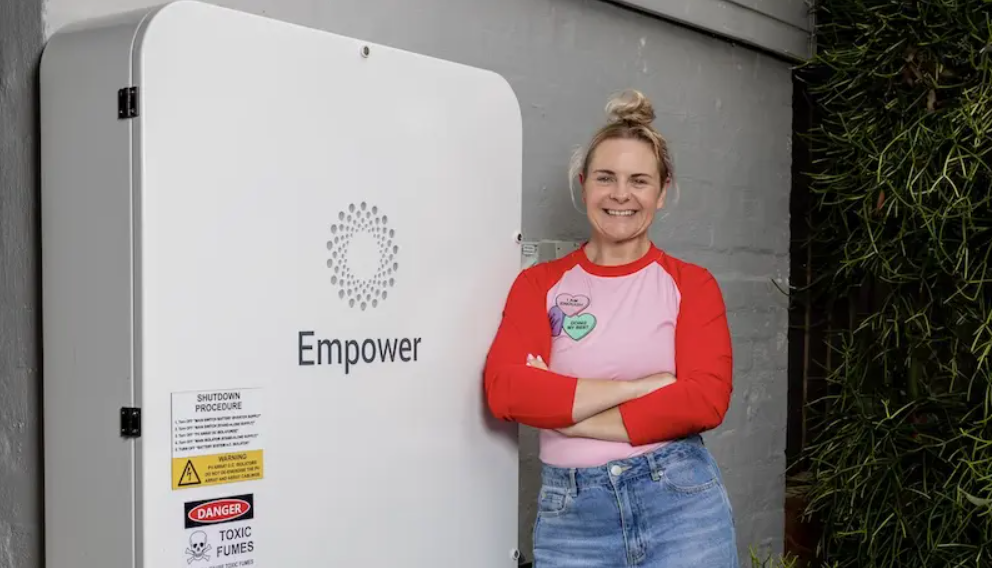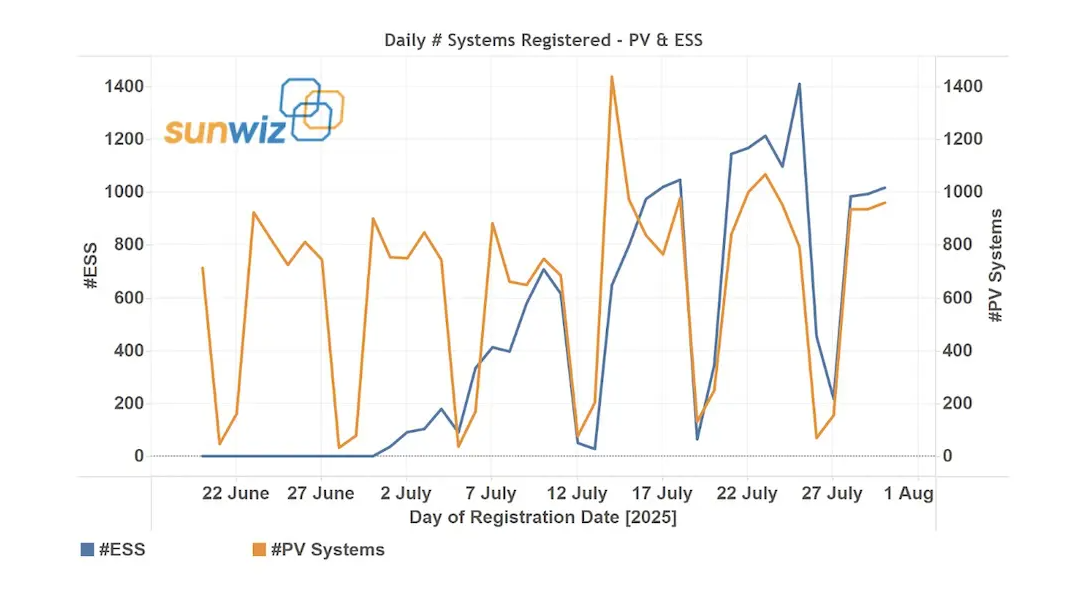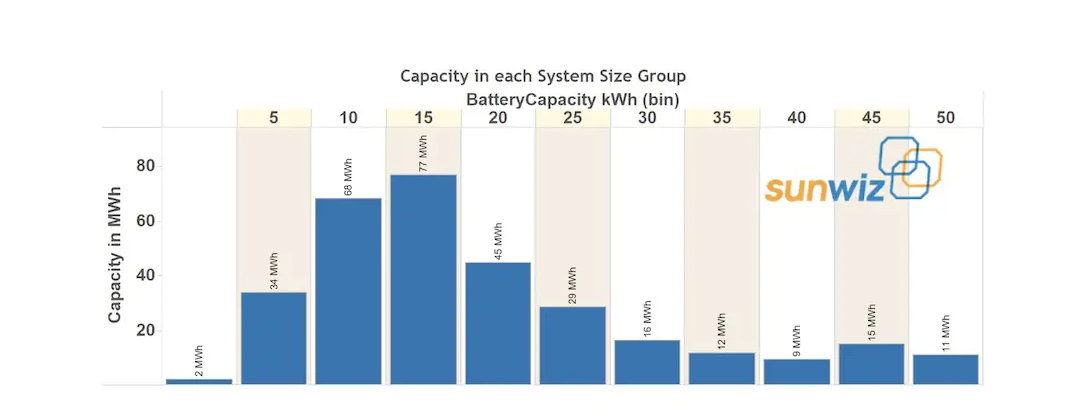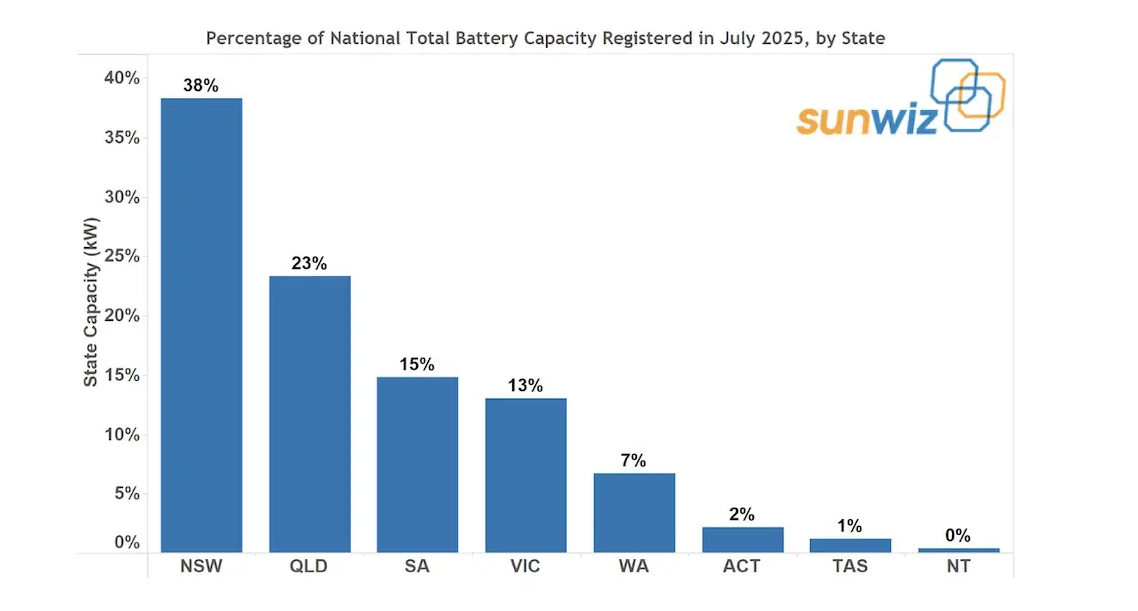Home battery blitz: “Astonishing” numbers mark first month of game-changing rebate

Australian households have installed close to 20,000 battery systems in the first month of the Cheaper Home Batteries rebate, more than one quarter of the total amount of systems installed for all of 2024.
The stunning numbers were revealed in the latest data from industry analyst SunWiz, which puts the nation on track to install more than 220,000 home batteries over 12 months – more than three times the 72,500 installed in 2024.
Federal Labor’s $2.3 billion Cheaper Home Batteries program was unveiled just weeks before the federal election and launched on July 01 to huge popular demand.
The rebate, which cuts the up-front cost of home battery installation by an average of around 30 per cent, is being rolled out through the existing Small-scale Renewable Energy Scheme that has so successfully helped Australia to become a global leader in rooftop solar uptake.
In a report on its first month in action, SunWiz says more than 19,000 home battery systems (19,592 according to the Clean Energy Regulator) were registered for subsidy support through the scheme, with uptake rates increasing weekly.
Registrations peaked at 1,400 in a single day, before stabilising to around 1,000 per day by the end of July – a rate SunWiz says is likely to remain steady while the industry works to maintain stock levels and train new installers.
The number of daily battery registrations started to overtake solar in the second-half of the month – a major milestone for the Australian market that was first marked by SunWiz on July 16.
As the chart below illustrates, this has since happened on a number of days. Across the month, there were 72 batteries installed for every 100 new PV systems, the data shows.

But in the week of July 15 – 21, that ratio surged to 137 batteries per 100 PV installs, reflecting what SunWiz has described as a temporary but powerful flip in market dynamics.
In the following week, more than 115 MWh of battery capacity was registered – an “astonishing figure,” says SunWiz, compared to the 852 MWh total installed in 2024, most of which came in the second half of the year.
“Uptake has been incredibly strong in the first month of the Cheaper Home Batteries Program,” SunWiz managing director Warwick Johnston said on Friday.
“In just one week, Australians installed more battery capacity than in the entire first two months of 2024.”
Johnston says the batteries being installed through the scheme are also seeing a significant increase in total system capacity, jumping from an average of 10-12 kWh (kilowatt-hours) in previous years to an average capacity of 17 kWh in July.

This has resulted in a whopping 344.1 megawatt-hours (MWh) of new energy storage capacity being added behind the meter on Australia’s grid in a single month – comparable to the capacity a big, grid-scale battery.
“Many households recognise this may be a one-time opportunity to access a significant subsidy, and they’re using it to invest in larger batteries,” Johnston says.
“Thanks to economies of scale, larger systems offer better value per kilowatt-hour, so the subsidy is having a strong multiplier effect.”
According to the SunWiz data, the most commonly installed home battery sized installed through the SRES in July were 13kWh, 19kWh, 9kWh and 15kWh.
On a state-by-state basis, New South Wales led the nation for installs, accounting for 38 per cent of all registered storage for the first month of the scheme. Queensland followed with 23 per cent, then South Australia (15%) and Victoria (13%).

South Australia, meanwhile, claims the highest storage-to-solar ratio in the country, with 150 home battery installations for every 100 new PV systems in July, in keeping with its status as the most renewable-powered state Australia.
Meanwhile, Australia’s consumer watchdog has warned that it is on the lookout for dodgy sales practices from solar and battery suppliers taking part in the subsidy scheme, as consumers rush to install discounted batteries.
In its latest Electricity Inquiry Report, the Australian Competition and Consumer Commission finds that while the rebate is making batteries more affordable and helping more households lower their electricity bills, it must be carefully regulated.
“As more Australian households switch to battery and solar plans, it’s important that the deals on offer are fair, accurate and easy to understand,” ACCC Commissioner Anna Brakey said.
“The ACCC will be watching carefully and actively monitoring consumer complaints. We will hold solar and battery installers, retailers and suppliers accountable to ensure they comply with Australia’s consumer laws.”
The Clean Energy Regulator (CER), which governs the SRES, says safety is also paramount as home battery uptake booms.
“Our inspection program is now underway on new solar batteries that have claimed the discount under the scheme,” said CER executive general manager of SRES operations division, Carl Binning, on Friday.
“We’ll publish inspection findings later this month once enough inspections have been completed to identify trends, and draft findings have been confirmed through due processes.
“Inspection findings will be shared with state and territory electrical and safety regulators who are responsible for ensuring compliance with relevant standards and regulations within their jurisdictions.
“We also share the findings with industry bodies like Solar Accreditation Australia to inform their compliance program and Continuing Professional Development program,” Binning said.
More information: https://onestepoffthegrid.com.au/home-battery-blitz-astonishing-numbers-mark-first-month-of-game-changing-rebate/


